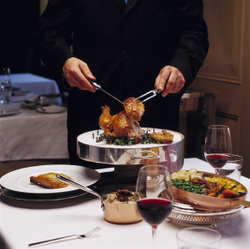Jidori Chicken.
All of a sudden it’s popping up on menus everywhere and diners are sitting there, nodding knowingly, and pretending they know exactly what the heck it is.
Am I the only one who’s wondering?
Is it chicken doused in a sauce of green melon liqueur?
Is it a bird that plays the violin?
Does it have anything to do with a holy war?
What the…? What the…?
After ordering a few of the trendy birds in restaurants around the Southland, and finding nothing particularly unusual about them, I decided to check out the phenomenon and share my findings on this morning's SignOnRadio show, The Gourmet Club. 
Turns out Jidori is an exotic-sounding name – and usually a correspondingly higher pricetag – for a nice fresh chicken, raised sustainably, never frozen, and sold locally
It all started in Japan, where the Jidori is, indeed, a prized, pure breed of chicken. Some time ago, some clever soul over there cross-bred a Hinaidori chick with a Rhode Island Red and got the prized Akita Hinai-Jidori. Akita is the local prefecture; Hinai is the town.
Jidori translates roughly as “chicken of the earth” or “ground chicken” (not as in hamburger but as in free-range, ground-scratching).
In Japan, the birds are raised by a handful of farmers who say they feed the chicks tomatoes and apples and “thawing waters” from the nearby Ou Mountains. Even more important is the fact that the slaughtered birds are in the hands of chefs and home cooks within hours. No freezing ever. No long hauls to the market.
So much for Japan.
Here in the U.S., Jidori chicken got its first close-up in, where else, L.A. In the early 1990s, the city’s famous Japanese chefs all wanted Jidori chicken on their menus. According to Dennis Mao, the enterprising gent who created the company JidoriChicken, he couldn’t import enough of the precious birds for demanding chefs so he contracted with farms in the Central Valley to grow an all-natural, free-range bird that would come close to the real thing.
Technically, all the restaurants in the U.S. touting Jidori chicken should be saying Jidori-STYLE chicken. Whatever. In the right hands, they are fresh, plump, creamy-tasting birds with lots of flavor and no hormones or antibiotics.
"They aren't like a special breed, and I'm not massaging those chickens," Mao quipped in an article in the Seattle Post-Intelligencer. "I wish it were more glamorous, but it's just a good-quality bird that gets to you in less than 24 hours."
Some of the interesting restaurant renditions I’ve discovered include a golden, cracklingly crisp whole chick, deep-fried, at The Stonehill Tavern of the St. Regis Monarch Bay Hotel in Laguna Niguel (the creation of super-chef Michael Mina is pictured above); and a crispy chicken served with Chinese sausage, egg, rice and licorice broth at Jack’s La Jolla.
Patina in L.A. scents the chicken with fresh lavender. Stingaree in downtown’s Gaslamp Quarter wraps it in a honey-almond crust. And at Urban Solace in North Park, the Jidori-style chick is brined, roasted, “pulled,” and served with buttermilk dumplings.
Here’s a recipe from Epicurious.com to try out on your friends. Serve it with a nice Rosé (come on, it’s Springtime) and a mini tutorial entitled “Exactly what is Jidori chicken?”
CHICKEN WITH 40 CLOVES OF GARLIC
Serves 4
1 (4-lb) chicken
1/2 teaspoon salt
1/4 teaspoon black pepper
1 scant cup olive oil
2 fresh parsley sprigs
1 fresh rosemary sprig
1 fresh thyme sprig
1 fresh sage sprig
1 bay leaf (not California)
1 celery rib
40 garlic cloves, peeled (from 3 to 4 heads of garlic)
Toast pieces
Preheat oven to 350°F.
Rinse chicken and pat dry. Sprinkle inside and out with salt and pepper. Tie legs together with kitchen string and fold wings under chicken.
Heat oil in a 6- to 8-quart wide heavy ovenproof pot over moderately high heat until hot but not smoking, then brown chicken, turning it carefully, until golden brown, about 10 minutes. Transfer chicken to a plate.
Tie herbs and celery together with kitchen string to make a bouquet garni and add to pot along with garlic cloves. Put chicken, breast side up, on top of cloves and bake, covered tightly, in middle of oven, basting twice, until cooked through and an instant-read thermometer inserted 2 inches into fleshy part of a thigh (avoid bone) registers 170°F, 30 to 40 minutes.
Transfer chicken to a cutting board, reserving pan juices, and let stand 10 minutes. Cut chicken into serving pieces and spread roasted garlic on toasts. Serve chicken drizzled with some of reserved pan juices.

Comments